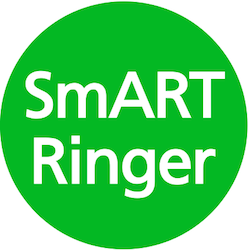Along with the other learners in my tower, I’m in the process of learning Plain Hunt, mostly Doubles with covering tenor. We started out ringing the 3rd bell, as that way the order that you follow the other bells is easy as it’s just round in a circle – 4,5,1,2,4,5,Lead,Lead,1,2. Unsurprisingly the next thing we are encouraged to do is ring on different bells, and ring Plain Hunt Minor without a cover. I know we are all exhorted to ring by ropesight as soon as (in)humanly possible but I simply don’t have enough of it yet, and in any case, as Steve Coleman says in one of his excellent books, it’s an open secret that beginners almost always start by ‘ringing by bell number’. That gave me a dilemma – I don’t have a very good head for remembering lists and even if I did, I’m just too lazy to bother to learn them for each bell 😉 I therefore wanted to figure out how Plain Hunt ‘worked’, because that way I’d be able to construct the order for any position and for any number of bells.
I’ve done a lot of reading of various bits and pieces on the internet, some of it helpful, some of it less so and some of it the opposite, so I thought I’d note down the things I’ve found useful in one place.
The thing that struck me most about the diagram above is that for any particular row, approximately half the lines are going to the right (ringing up to the back) and half are going to the left (ringing down to the front). From that follow some things that I found helpful:
- All odd bells always start by ringing up to the back, all even ones always start by ringing down to the front. There’s one exception – if you are ringing last and on an odd bell, you ring one extra handstroke before you start moving down.
- If you are ringing up to the back, you are going to start by ringing after the bell that’s after you, to your left – just like you do in a call change.
- If you are ringing down to the front then it’s the bell that’s three in front of you that you start with. That vexed me a little at first – why three and not two? Well, you are already ringing after the bell that’s in front of you, obviously, so you need to ring after the bell that’s before it. But the bells before you are also all swapping places as well, so if you are ringing 4, then the 1 & 2 will have have swapped just before you (4) and the 3 get to do your dance, so the order will be (2,1), then you (4) then 3 – so you have to ring after the treble on the first change. Simple, huh? No, probably not 😉
- For Plain Hunt, the order of bells you ring after as you ring up to the back is the same as the order as you ring down to the lead. That means you only have to learn half of it 🙂
- If you are on an even bell then you are going to lead on the first “trip around the other bells”, if you are on an odd bell it’s the second time around.
- And finally, my favourite rule – “Up the evens, down the odds”. What that means is that if (say) you are ringing 3, you ring over 4 first (see above). There aren’t any higher-numbered even bells, so you start with the highest-numbered odd bell (5), then go down the odds – you can’t ring after yourself (3) so next you ring over the 1, there are no lower odd numbered bells so you start again with the lowest even numbered bell (2), then 4, 5, Lead, Lead, then 1, 2 – hey presto, back in rounds, how did that happen!
The great thing is that these rules for Plain Hunt work no matter what bell you are on and how many bells are ringing, so if you can internalise them you can throw away your blue line diagrams and amaze the more experienced ringers in your tower with your skills – OK, perhaps not, but they will appreciate you being able to ring a different bell or on a different number of bells without you spending 15 minutes pouring over a blue line diagram, or them shouting numbers at you as you ring.
Putting all of this together, visually it becomes a scan across the other bells, moving one way 2 bells at a time, then the other way 2 at a time. I’ve been watching more experienced ringers and despite all the mystique about ropesight, most of them start looking in approximately the right direction before they’ve focussed on the bell they are following. That says to me that they have in inner sense of how the bells move past each other and they use that as the first step in identifying the bell to follow next.
Here’s a final thing you can use to astound your ringing teacher. If you look at the diagram above, on each row there’s only bell on each row that rings in the same place and doesn’t swap. In the first row it’s the fifth bell, in the second row it’s the first bell, then it repeats over and over – first bell rings in place, fifth bell rings in place. Why? Well on the first row the positions that trade places are (1,2),(3,4) and the poor old 5th has nobody to dance with. If we repeated that again then we’d end up straight back in rounds, so next time around the bell in position 1 is all on its lonesome and (2,3),(4,5) swap. Then it just cycles round over and over – position 5 rings in place, then position 1 and so on until we get back into rounds. Note that’s bell position, not the number of the bell itself. So we can describe the whole of Plain Hunt Doubles by just saying which bell positions ring in place. That’s the basics of the Dark Art known as place notation, so next time your ringing teacher asks you to write out Plain Hunt Doubles on the whiteboard, just write:
5,1
and walk away with a smug look on your face 🙂



I too am learning plain hunt and going through the same thought processes! Just one query though, isn’t bullet point 5 the wrong way round, odds lead second time around?
Oops, yes Claire you are absolutely right! I’ve corrected the post, thanks 🙂